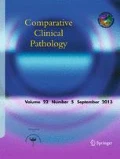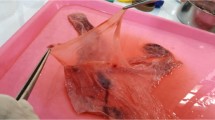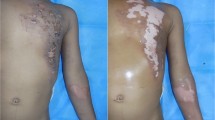Abstract
Skin burn injuries result in loss of its protective function as a barrier and leading to a high risk of infection. Therefore, effective treatments and healing of burn injuries are very important to prevent complications. Amniotic membrane (AM) as a biological dressing inhibits the loss of vital fluids, water, and protein. The aim of this study was to compare the healing effects of AM and silver sulfadiazine (SSD) ointment in third-degree burn injuries in experimental rat model. Fifty-four male Sprague–Dawley rats were divided randomly into three equal groups. After induction of third-degree burn, transplantation of human AM (HAM) and SSD ointment used on wound area for treatment groups. The third group was considered as control. At days 7, 14, and 21, histopathological evaluation of burn wound area was performed using light microscopy. After 21 days, burn injury in HAM group showing lack of enough wound contraction and decrease in wound area in comparison to SSD group. Also, the healing effects were demonstrated using decline of inflammatory cell infiltration and enhanced epithelium after 21 days. The total wound score was significantly higher in the HAM group than the control and SSD ointment groups, during and at the end of the experiment (P < 0.05). On day 21, significantly lesser inflammatory cell infiltration was noticed in the control group (P < 0.05). Our findings showed that HAM can be used successfully as a biological treatment for experimental third-degree burn injury in animal model.



Similar content being viewed by others
References
Akhoondinasab MR, Akhoondinasab M, Saberi M (2014) Comparison of healing effect of Aloe vera extract and silver sulfadiazine in burn injuries in experimental rat model. World J Plast Surg 3:29–34
Amini M, Kherad M, Mehrabani D, Azarpira N, Panjehshahin MR, Tanideh N (2010) Effect of Plantago major on burn wound healing in rat. J Appl Anim Res 37:53–56
Artz CP, Rittenbury MS, Yarbrough DR 3rd (1972) An appraisal of allografts and xenografts as biological dressings for wounds and burns. Ann Surg 175:934
Ashkani-Esfahani S et al (2012) The healing effect of Arnebia euchroma in second degree burn wounds in rat as an animal model. Iran Red Crescent Med J 14:70
Atiyeh BS, Costagliola M, Hayek SN (2009) Burn prevention mechanisms and outcomes: pitfalls, failures and successes. Burns 35:181–193
Atiyeh BS, Costagliola M, Hayek SN, Dibo SA (2007) Effect of silver on burn wound infection control and healing: review of the literature. Burns 33:139–148
Bose B (1979) Burn wound dressing with human amniotic membrane. Ann R Coll Surg Engl 61:444
Daryabeigi R, Heidari M, Hosseini SA, Omranifar M (2010) Comparison of healing time of the 2nd degree burn wounds with two dressing methods of fundermol herbal ointment and 1% silver sulfadiazine cream. Iran J Nurs Midwifery Res 15:97
Enken Drecoll MD, Lars Steinstraesser MD (2014) Evaluation of human amniotic membrane as a wound dressing for split-thickness skin graft donor sites. BioMed Research International
Fuller FW (2009) The side effects of silver sulfadiazine. J Burn Care Res 30:464–470
Gruss JS, Jirsch DW (1978) Human amniotic membrane: a versatile wound dressing. Can Med Assoc J 118:1237
Gupta A, Keshri GK, Yadav A, Gola S, Chauhan S, Salhan AK, Bala Singh S (2014) Superpulsed (Ga-As, 904 nm) low-level laser therapy (LLLT) attenuates inflammatory response and enhances healing of burn wounds. J Biophotonics 9999
Haberal M, Oner Z, Bayraktar U, Bilgin N (1987) The use of silver nitrate-incorporated amniotic membrane as a temporary dressing. Burns 13:159–163
Hazrati M, Mehrabani D, Japoni A, Montasery H, Azarpira N, Hamidian-Shirazi AR, Tanideh N (2010) Effect of honey on healing of Pseudomonas aeruginosa infected burn wounds in rat. J Appl Anim Res 37:161–165
Hojati H, Kazemi K, Tanideh N, Syvani E, Roshan N (2004) The effect of egg yolk and gum tragacunt ointment on wound healing: an experimental study on rabbits. J Med Res (JMR) 2:33–39
Hosseini SV, Niknahad H, Fakhar N, Rezaianzadeh A, Mehrabani D (2011) The healing effect of mixture of honey, putty, vitriol and olive oil in Pseudomonas aeroginosa infected burns in experimental rat model. Asian J Anim Vet Adv 6:572–579
Hosseini SV, Tanideh N, Kohanteb J, Ghodrati Z, Mehrabani D, Yarmohammadi H (2007) Comparison between Alpha and silver sulfadiazine ointments in treatment of Pseudomonas infections in 3rd degree burns. Int J Surg 5:23–26
Kanyshkova TG, Buneva VN, Nevinsky GA (2001) Lactoferrin and its biological functions. Biochem Mosc 66:1–7
Koob TJ, Lim JJ, Massee M, Zabek N, Denozire G (2014) Properties of dehydrated human amnion/chorion composite grafts: implications for wound repair and soft tissue regeneration. J Biomed Mater Res B Appl Biomater 102:1353–1362
Loeffelbein DJ et al. (2014) Evaluation of human amniotic membrane as a wound dressing for split-thickness skin-graft donor sites. BioMed Research International 2014
Mehrabani D, Farjam M, Geramizadeh B, Tanideh N, Amini M, Panjehshahin MR (2015) The healing effect of curcumin on burn wounds in rat. World Journal of Plastic Surgery 4
Niknejad H, Peirovi H, Jorjani M, Ahmadiani A, Ghanavi J, Seifalian AM (2008) Properties of the amniotic membrane for potential use in tissue engineering. Eur Cells Mater 15:88–99
Rinastiti M, Santoso ALS, Sosroseno W (2006) Histological evaluation of rabbit gingival wound healing transplanted with human amniotic membrane. Int J Oral Maxillofac Surg 35:247–251
Rizzuti A, Goldenberg A, Lazzaro DR, Goldenberg A, Lazzaro DR (2014) Amniotic membrane allografts: development and clinical utility in ophthalmology. Clin Ophthalmol 8:2491–2499
Robson MC, Krizek TJ (1974) Clinical experiences with amniotic membranes as a temporary biologic dressing. Conn Med 38:449
Silver S, Phung LT, Silver G (2006) Silver as biocides in burn and wound dressings and bacterial resistance to silver compounds. J Ind Microbiol Biotechnol 33:627–634
Solomon A, Rosenblatt M, Monroy D, Ji Z, Pflugfelder SC, Tseng SCG (2001) Suppression of interleukin 1α and interleukin 1β in human limbal epithelial cells cultured on the amniotic membrane stromal matrix. Br J Ophthalmol 85:444–449
Tanideh N, Haddadi MH, Rokni-Hosseini MH, Hossienzadeh M, Mehrabani D, Sayehmiri K, Koohi-Hossienabadi O (2015) The healing effect of Scrophularia striata on experimental burn wounds infected to Pseudomonas aeruginosa in rat. World Journal of Plastic Surgery 4
Tanideh N et al (2014) The healing effect of licorice on Pseudomonas aeruginosa infected burn wounds in experimental rat model. World J Plast Surg 3:99
Upadhyay NK, Kumar R, Siddiqui MS, Gupta A (2011) Mechanism of wound-healing activity of Hippophae rhamnoides L. leaf extract in experimental burns. Evid Based Complement Alternat Med 2011:659705
Xue L et al (2013) Effects of human bone marrow mesenchymal stem cells on burn injury healing in a mouse model. Int J Clin Exp Pathol 6:1327
Acknowledgment
The authors appreciate kind support of the Stem Cells and Transgenic Technology Research Center, Shiraz University of Medical Sciences, Shiraz, Iran.
Author information
Authors and Affiliations
Corresponding author
Ethics declarations
This study was approved by the Animal Care and Use Committee of Shiraz University of Medical Sciences, Shiraz, Iran. All efforts were made to prevent any unnecessary and harmful animal handling.
Conflict of interest
The authors declare that they have no competing interests.
Rights and permissions
About this article
Cite this article
Sedighi, A., Mehrabani, D. & Shirazi, R. Histopathological evaluation of the healing effects of human amniotic membrane transplantation in third-degree burn wound injuries. Comp Clin Pathol 25, 381–385 (2016). https://doi.org/10.1007/s00580-015-2194-9
Received:
Accepted:
Published:
Issue Date:
DOI: https://doi.org/10.1007/s00580-015-2194-9




